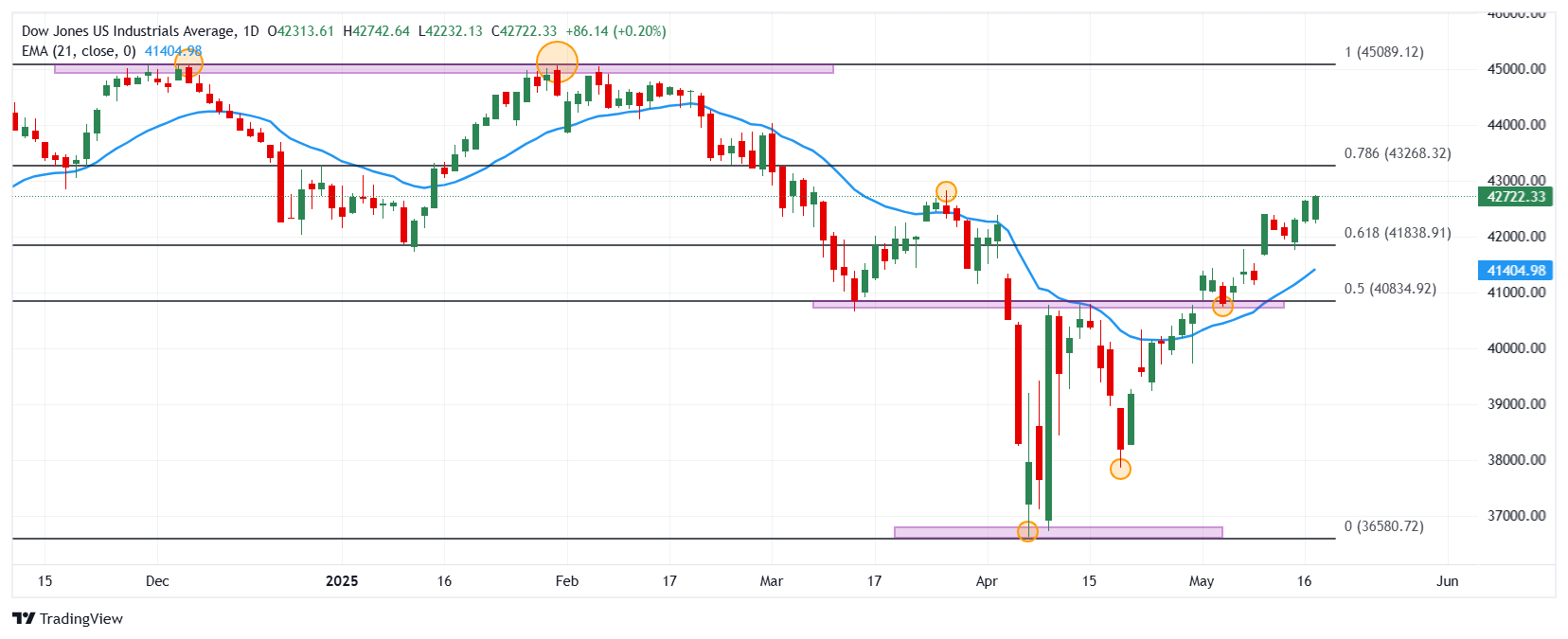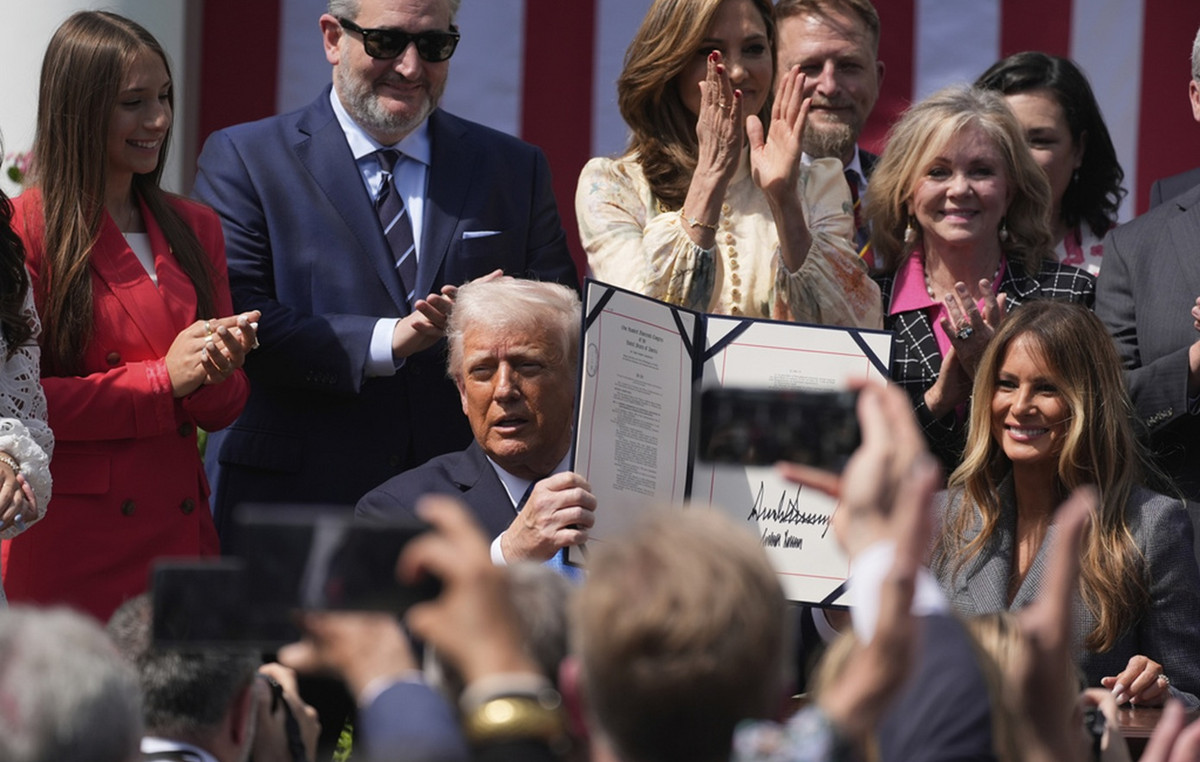- The Dow Jones advances 0.21% today, operating at the time of writing about 42,617.
- The Nasdaq 100 decoced 0.22% in the day, reaching minimums of Nayo 13 in 21,370.
- The S&P 500 falls 0.16% daily, dragged by First Solar (FSLR).
- The Moodýs credit agency cut the qualification of the sovereign debt of the United States to AAA1 from AA1.
- The president of the Fed of New York, John Williams, recognized the commercial uncertainty that prevails in the short term.
The Dow Jones marked a daily maximum in 42,646, finding vendors that took the index to minimum of May 15 in 42,232.
The Dow Jones industrial average opened 42,313, while the Nasdaq 100 technological index began operating at 21,383. The S&P 500 began negotiations in 5,921, consolidating within Friday’s operational range.
UnitedHealth and Visa drive Dow Jones to profit zone
The Dow Jones index rises 0.21% on Monday, currently quoting at 45,726.
The values of UnitedHealth (UNH) earn 7.70% today, reaching May 14 at 315.33 $., Signing its second consecutive upward day.
On the other hand, visa (v) shares recover 0.92% daily, establishing a new historical maximum in 368.71 $, signing its ninth consecutive session with profits.
In this context, Dow Jones advances 92 points, reaching maximums not seen since March 26 at 42,742.
Palantir Technologies and Tesla lead the losses in Nasdaq 100
The Nasdaq 100 technological index slides 0.22% on Monday, bouncing from May 13 at 21.039.
Palantir Technologies (PLT) titles lose 3.39% in the first day of the week, falling to minimums of almost a week at $ 124.32.
In the same tune, the values of Tesla (TSLA) go back 3.59% in the day, oscillating within the operating range of May 13 in 337.66 $, leading losses in the technological index.
The Nasdaq 100 falls 51 points, consolidating within the operational range of the previous session at 21,375.
The S&P 500 operates in negative terrain after the reduction of credit rating to the United States
The Moody´s qualifying agency adjusted to the decline the sovereign debt of the United States to AA1 from AAA, citing an increase in the cost of financing of the debt, greater than that of sovereigns with similar grades, anticipating a federal load of GDP by 2035 of 134%.
On the other hand, the President of the Federal Reserve of New York, John Williams, highlighted the strength of economic data in his speech today, although he recognized uncertainty in relation to international trade.
In this sense, the S&P 500 falls 0.16% in the day, retreating 12 points, staying in the operational range of the previous session. The shares of First Solar (FSLR) collapse 8.49% today, approaching May 12 at $ 162.94, spinning three consecutive sessions down.
Technical Analysis of Dow Jones
The Dow Jones reacted upwards from a short -term support given by the minimum of May 6 in 40,747. The following key support is 36.614, minimum of April 7. To the north, the important resistance is observed in 45,068, pivot point of January 31.
Dow Jones daily graphics

Dow Jones Faqs
The Dow Jones Industrial Avenge, one of the oldest stock market indexes in the world, consists of the 30 most negotiated values in the United States. The index is weighted by the price instead of capitalization. It is calculated by adding the prices of the values that compose it and dividing them by a factor, currently 0.152. The index was founded by Charles Dow, also founder of the Wall Street Journal. In recent years it has been criticized for not being sufficiently representative, since it only follows 30 companies, unlike broader rates such as S&P 500.
There are many factors that promote the Dow Jones Industrial Average (DJIA) index. The main one is the added performance of the companies that compose it, revealed in the quarterly reports of business benefits. The American and world macroeconomic data also contribute, since they influence investor confidence. The level of interest rates, set by the Federal Reserve (FED), also influences the DJia, since it affects the cost of credit, on which many companies depend largely. Therefore, inflation can be a determining factor, as well as other parameters that influence the decisions of the Federal Reserve.
Dow’s theory is a method to identify the main trend of the stock market developed by Charles Dow. A key step is to compare the direction of the Dow Jones Industrial Avenge (DJIA) and the Dow Jones Transportation Average (DJTA) and just follow the trends in which both move in the same direction. The volume is a confirmation criterion. The theory uses elements of maximum and minimum analysis. Dow’s theory raises three phases of the trend: accumulation, when intelligent money begins to buy or sell; Public participation, when the general public joins the trend; and distribution, when intelligent money abandons the trend.
There are several ways to operate with the DJ. One of them is to use ETF that allow investors to negotiate the DJ as a single value, instead of having to buy shares of the 30 companies that compose it. An outstanding example is the SPDR Dow Jones Industrial Avenge ETF (day). Future contracts on the DJ allow the specular operators about the future value of the index and the options provide the right, but not the obligation, to buy or sell the index at a predetermined price in the future. Investment funds allow investors to buy a part of a diversified portfolio of DJ values, which provides exposure to global index.
Source: Fx Street
I am Joshua Winder, a senior-level journalist and editor at World Stock Market. I specialize in covering news related to the stock market and economic trends. With more than 8 years of experience in this field, I have become an expert in financial reporting.







